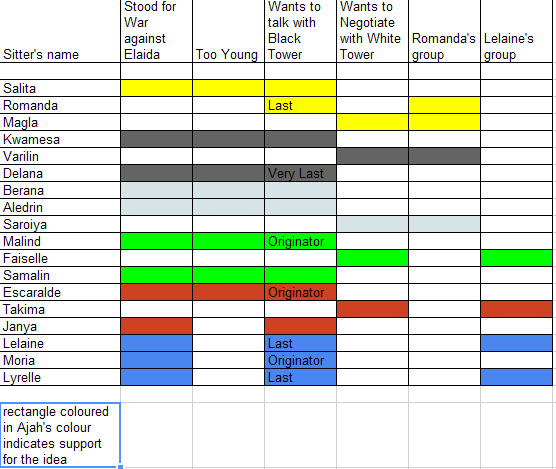In this section Egwene is plunged into the deepest depths of Aes Sedai intrigue…
The final part of this Egwene section is a study in Aes Sedai politics that makes your head spin. There have been several mentions of the too-young Sitters, and Siuan has discovered that Elaida has the same problem. In Tar Valon there are at least three, maybe four Sitters who are too young by custom. Egwene has another eight. It would have stood out as strange in either place, but together they point to somebody who has a hand in all Ajahs and is directing their decision-making. Once the Black Ajah has been ruled out, Siuan and Egwene can’t even conceive that the Ajah Heads not only know each other but may be communicating secretly with each other.
This is the behaviour Talene was investigating, which led to her capture by the Black Ajah hunters. Some of the Sitters had been meeting secretly, but Talene and the Black Ajah and Mesaana herself did not know their purpose. Interestingly, the Ajah heads meeting and the too-young Sitter mysteries solve each other, so we know who is behind it, and some of what they have done, but their motive is still lacking. Some readers may have the intuition to look at the unknowns and wonder how they may fit together to get this far, but I think most often they remain categorized as two separate mysteries.
Egwene’s meeting with the Hall goes on for pages, with every mannerism and action potentially laden with meaning. The author convincingly shows how much noise there is covering the true signal. One tool to help simplify our understanding of this mess is a grid showing common stances on certain issues.
Now we can more easily see the pattern that Siuan was getting at. When those five Sitters started pressing for negotiations, Egwene should have wondered whether it meant that Romanda and Lelaine were supportive of it, given the affiliations those five shared. It is much easier to see that long-time Sitters outside the Blue Ajah viscerally oppose talks with the Black Tower and favour all reunification measures, including refusal to declare war on Elaida.
The question is why didn’t the author make this plainer to the reader? He could easily have had Egwene notice this pattern and comment on it, or summarized the votes as “the newly raised Sitters were amenable to change, the ones raised before the split would die before agreeing to this proposal.” Instead, he spread one vote over six entire pages, challenging readers to cobble together clues from this section as well as from several other books to even have a clear idea of who is in the Hall and what the factions may be. He wanted readers to work for the answer and to have a life-like representation of the political complexities the Amyrlin faces with every proposal. I wonder how much of the time it took to write Crossroads of Twilight is as a result of this decision to present this vote in such a detailed way. So many characters, so many details.
Egwene’s migraine headaches are an original disability. They don’t affect her ability to channel, but they do give an opportunity for Halima to get close to her. It’s debatable whether Halima could in some way be causing the headaches, but there is a grave risk of discovery if someone discovers a saidin resonance centered on Egwene’s tent. The metaphor works better if headaches are a natural outgrowth of Egwene’s difficulties with the Sitters and Halima’s touch offers to make the problems go away, which Egwene won’t accept, preferring to slog it out in the Hall.
To reinforce Egwene’s stance about Halima staying in her tent, one chapter opens with Egwene considering the rumours about her in the camp. The novices compare her to the stern Sereille Bagand, and Egwene recognizes that there is often little truth to rumours about her. This is soon contrasted to rumours about Halima breaking a man’s arm and being too free with her favours. If Egwene rejects gossip for personal reasons, because she knows it to be false, she now has a personal stake in not accepting gossip about Halima. That decision made, she becomes steadfast in the woman’s defense. She also has a personal need for Halima’s presence, since she is the only woman with whom she can stop being the Amyrlin for a few minutes. Ironically, this relationship helps Egwene remain grounded and not become a typical Aes Sedai.
The seed planted back in New Spring takes root, as Siuan reveals her suspicion that Cadsuane is Black Ajah. Just when we had started to trust her a bit.
Egwene proves she will do anything to reunite the Tower, holding her nose at having to use Rand’s apparent Compulsion of Aes Sedai to prove that he must not have submitted to Elaida. A foul-tasting tea acts as the metaphor throughout the discussion.
Writing Lessons:
Clues and solutions to mysteries can be hidden in noise, but the amount of noise can also be a deterrent to readers.

No comments:
Post a Comment